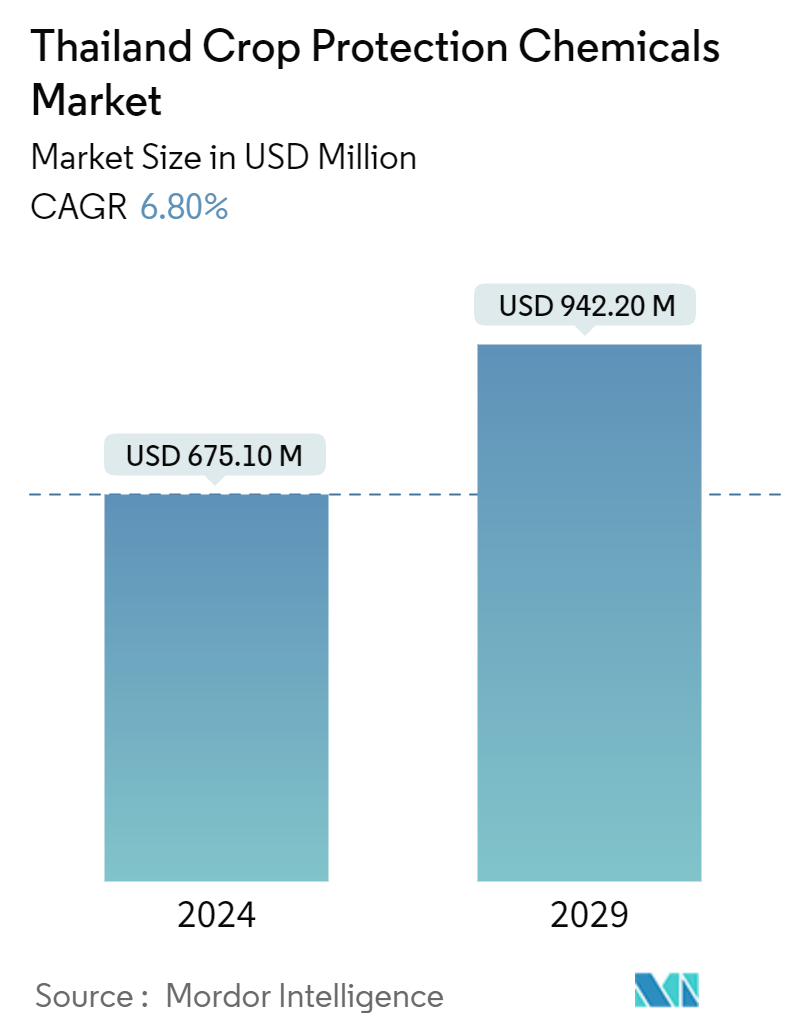Market Size of Thailand Crop Protection Chemicals Industry

| Study Period | 2019 - 2029 |
| Base Year For Estimation | 2023 |
| Market Size (2024) | USD 675.10 Million |
| Market Size (2029) | USD 942.20 Million |
| CAGR (2024 - 2029) | 6.80 % |
| Market Concentration | High |
Major Players
*Disclaimer: Major Players sorted in no particular order |
Thailand Crop Protection Chemicals Market Analysis
The Thailand Crop Protection Chemicals Market size is estimated at USD 675.10 million in 2024, and is expected to reach USD 942.20 million by 2029, growing at a CAGR of 6.80% during the forecast period (2024-2029).
The rapid increase in pesticide use in Thailand is expected to account for an increase in cash crops. Most pesticide-intensive crops, vegetables, and fruits are the highest cash value-added crops in Thailand. As farmers have gradually switched from low-value-added to high-value-added crop production, the overall consumption rate of pesticides has naturally increased.
- According to the Office of Agricultural Economics (OAE) and the Office of Agriculture Regulations (OAR), the usage of pesticides has increased significantly in recent years. The import value of pesticides increased from USD 649.8 million in 2020 to USD 885.1 million in 2021. The major reason for the increase in pesticide imports and use over the last decade is Thailand's significant role as a leading exporter of food and agricultural products.
- Insecticide classes commonly imported included organophosphate (OP, e.g., chlorpyrifos), carbamate (e.g., fenobucarb and methomyl), and pyrethroid. Paraquat, glyphosate, 2,4-D, ametryn, and atrazine were the most often imported herbicides. Dithiocarbamate, mancozeb, carbendazim, and captan were the most often imported fungicides in the previous years.
- The favorable tax policy of the Thai government toward the growing market of agrochemical imports, the promotion of sustainable and integrated pest management techniques, and the increased intensity of land use are the major drivers for the market.
Thailand Crop Protection Chemicals Industry Segmentation
Crop protection chemicals are a class of agrochemicals used to prevent the destruction of crops by insect pests, diseases, weeds, and other pests.
The Thai crop protection chemicals market is segmented by product (herbicides, insecticides, fungicides, molluscicide, and nematicide), crop (commercial crops, fruits and vegetables, grains and cereals, pulses and oil seeds, and turf and ornamental crops), and application (chemigation, foliar, fumigation, seed treatment, and soil treatment). The report offers market size and forecasts in terms of value (USD) for all the above segments.
| Product | |
| Herbicides | |
| Insecticides | |
| Fungicides | |
| Molluscicide | |
| Nematicide |
| Crop | |
| Commercial Crops | |
| Fruits and Vegetables | |
| Grains and Cereals | |
| Pulses and Oil seeds | |
| Turf and Ornamental Crops |
| Application | |
| Chemigation | |
| Foliar | |
| Fumigation | |
| Seed Treatment | |
| Soil Treatment |
Thailand Crop Protection Chemicals Market Size Summary
The Thailand crop protection chemicals market is experiencing significant growth, driven by the increasing use of pesticides in the cultivation of high-value cash crops such as rubber, coffee, and sugarcane. As farmers transition from low-value to high-value crop production, the demand for crop protection chemicals has surged. This shift is further supported by Thailand's role as a leading exporter of food and agricultural products, necessitating the import of various insecticides, herbicides, and fungicides. The government's favorable tax policies and promotion of sustainable pest management techniques are also contributing to the market's expansion. The horticultural sector, particularly the tropical fruit industry, plays a crucial role in this growth, with the increased use of agrochemicals ensuring steady production and higher yields.
The market is characterized by a few major global players, including Corteva Agriscience, Syngenta, ADAMA Agriculture Solutions, BASF SE, and Bayer Crop Science AG, alongside local traders. These companies are focusing on developing innovative products and technologies to enhance product quality. Recent product launches and strategic partnerships highlight the competitive landscape. Despite concerns over pesticide residues in fruits and vegetables, the intensity of pesticide use in Thailand remains lower than in some neighboring countries. The market's growth trajectory is expected to continue, supported by rising demand for agrochemicals and the ongoing expansion of cash crop production.
Thailand Crop Protection Chemicals Market Size - Table of Contents
-
1. MARKET DYNAMICS
-
1.1 Market Overview
-
1.2 Market Drivers
-
1.3 Market Restraints
-
1.4 Porter's Five Forces Analysis
-
1.4.1 Bargaining Power of Suppliers
-
1.4.2 Bargaining Power of Buyers/Consumers
-
1.4.3 Threat of New Entrants
-
1.4.4 Threat of Substitutes
-
1.4.5 Intensity of Competitive Rivalry
-
-
-
2. MARKET SEGMENTATION
-
2.1 Product
-
2.1.1 Herbicides
-
2.1.2 Insecticides
-
2.1.3 Fungicides
-
2.1.4 Molluscicide
-
2.1.5 Nematicide
-
-
2.2 Crop
-
2.2.1 Commercial Crops
-
2.2.2 Fruits and Vegetables
-
2.2.3 Grains and Cereals
-
2.2.4 Pulses and Oil seeds
-
2.2.5 Turf and Ornamental Crops
-
-
2.3 Application
-
2.3.1 Chemigation
-
2.3.2 Foliar
-
2.3.3 Fumigation
-
2.3.4 Seed Treatment
-
2.3.5 Soil Treatment
-
-
Thailand Crop Protection Chemicals Market Size FAQs
How big is the Thailand Crop Protection Chemicals Market?
The Thailand Crop Protection Chemicals Market size is expected to reach USD 675.10 million in 2024 and grow at a CAGR of 6.80% to reach USD 942.20 million by 2029.
What is the current Thailand Crop Protection Chemicals Market size?
In 2024, the Thailand Crop Protection Chemicals Market size is expected to reach USD 675.10 million.

